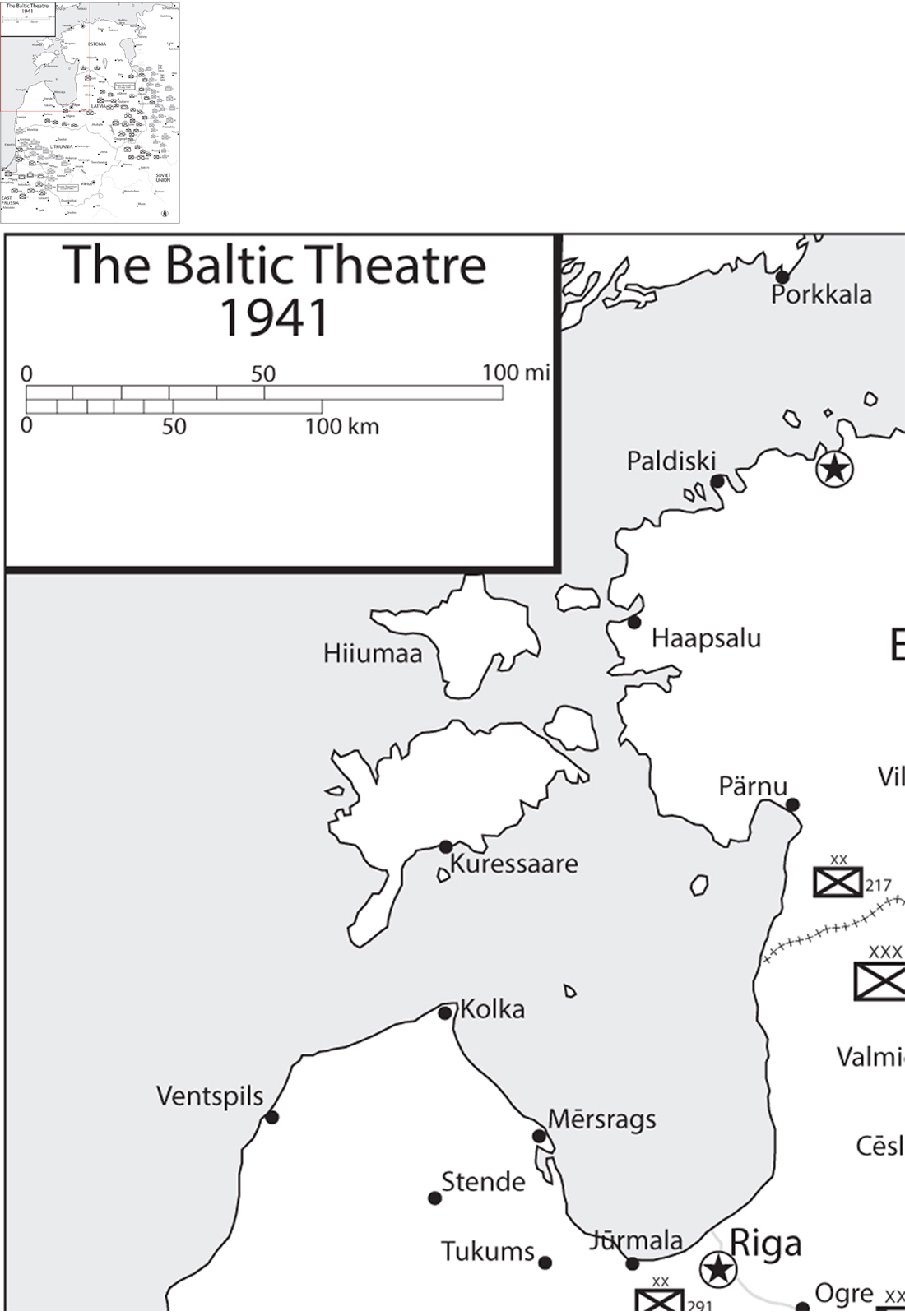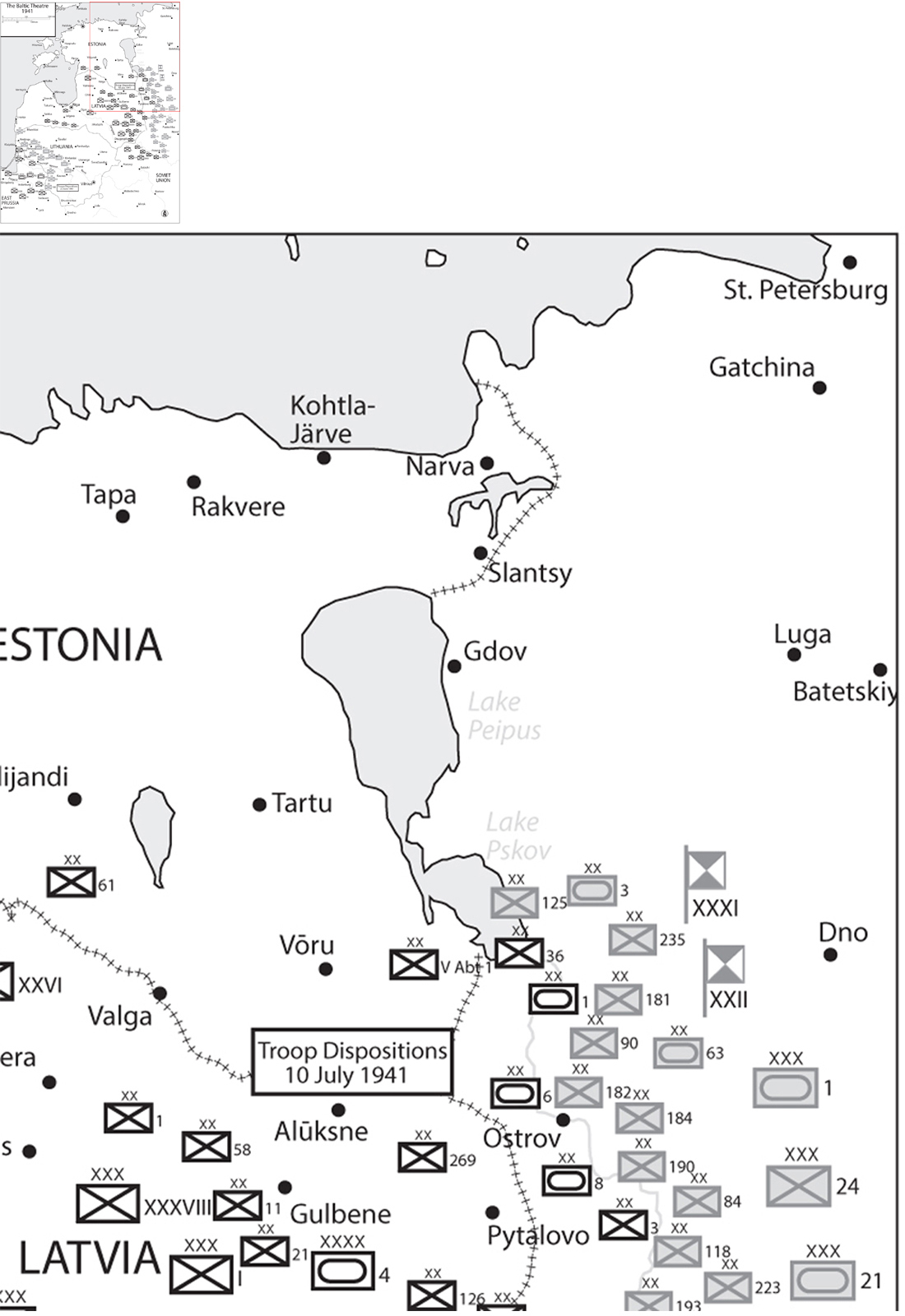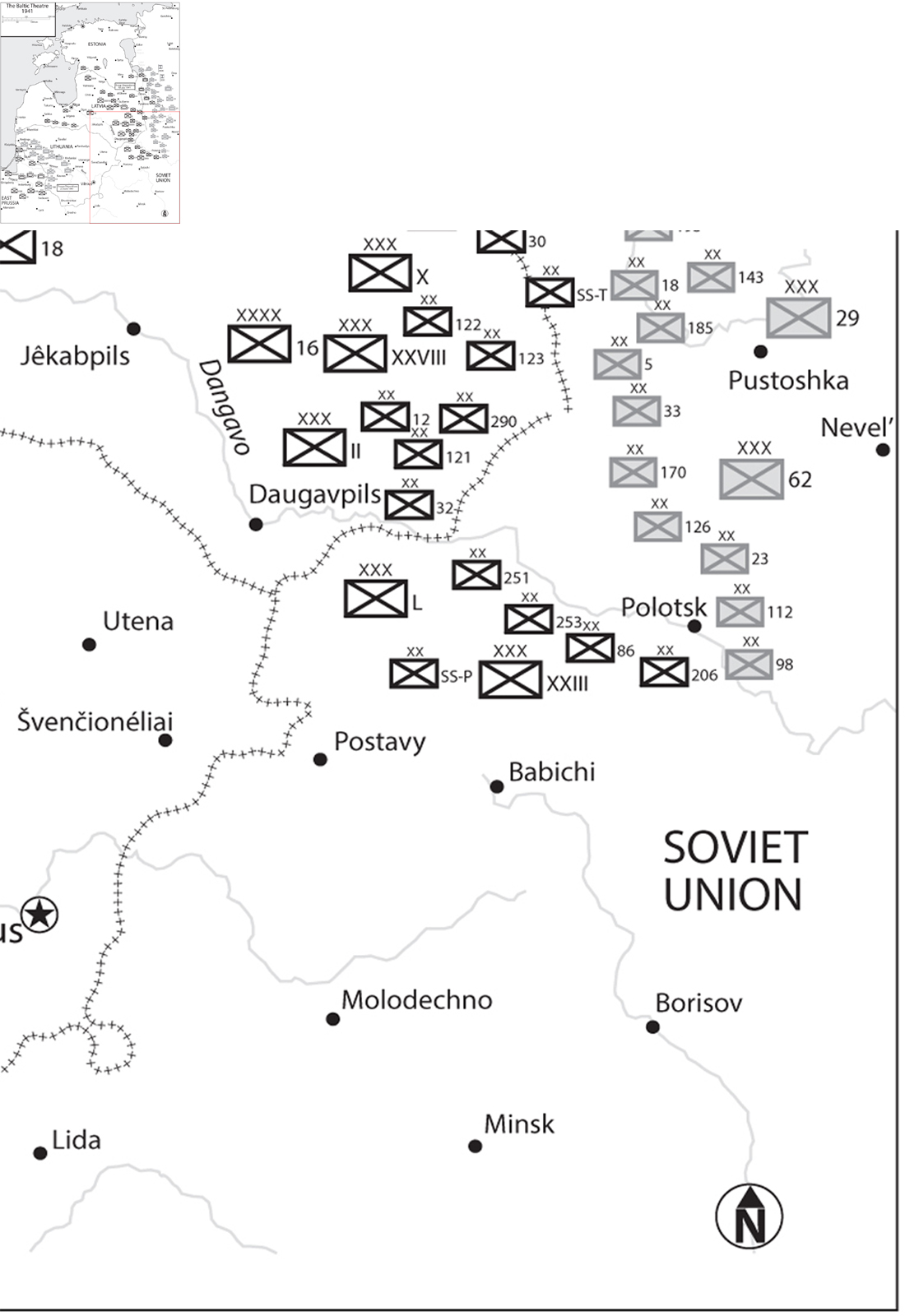Between Giants (13 page)
Authors: Prit Buttar
Tags: #Between Giants: The Battle for the Baltics in World War II

The widespread purges that followed Tukhachevsky’s execution effectively destroyed any possibility of the Soviet military command being able to show the sort of personal initiative so highly prized in the
Red Army Field Service Regulations
. Initiative became a dangerous trait for any Soviet officer, and was replaced by a rigid adherence to orders from above. The Red Army would therefore respond to the German assault in an inflexible manner, with units at all levels struggling to carry out orders that had been rendered meaningless by the pace of the German advance. It would take the Red Army several years to relearn the importance of allowing its officers the freedom to improvise and show initiative.
A further setback was an imprecise understanding of the lessons of the Spanish Civil War and the Winter War against Finland. These conflicts raised doubts about the value of large mechanised formations, and as a result Soviet armour was reorganised into smaller divisions instead of large tank corps. These new divisions would prove to be far too weak to stand against their equivalent German opponents in 1941. In light of the German successes of 1939 and 1940, attempts were made to reverse this trend, but these were incomplete by the onset of
Barbarossa
. Indeed, Timoshenko did not anticipate that the process would be finished until mid-1942.
32
The road to war was probably an inevitable one. Hitler clearly intended to attack the Soviet Union at some point, and preparations began over a year before the actual onset of hostilities. Meanwhile, at a political level at least, the Molotov–Ribbentrop Pact seemed to be working in the first few months. Moscow instructed communist parties across Europe to oppose the war, condemning the British and French as reactionary capitalists. Trade arrangements allowed Germany to escape the impact of any British attempts to enforce a blockade, but by the summer of 1940, the pact was showing signs of strain. Despite the explicit statements in the secret protocol about spheres of influence, the Germans were concerned about Soviet moves against Finland and the Baltic States, while the Soviet Union grew increasingly impatient with Germany’s failure to keep up with payments for grain and raw materials. The fall of France left Stalin feeling that war with Germany might come sooner rather than later, and he found it difficult to retain a veneer of courtesy when complimenting Schulenburg on the German victory. At one stage, he complained to Molotov: ‘Couldn’t they put up any resistance at all? Now Hitler’s going to beat our brains in!’
33
However, the continued resistance of Britain appeared to reassure Stalin that Hitler would remain occupied in the west, at least for the time being, and there was a brief relaxation in tension. In November 1940, Molotov visited Berlin for talks about the areas of friction between the two powers, particularly Finland and the Balkans. The Germans were evasive when Molotov tried to pin them down on their intentions in Rumania and Bulgaria. During the visit, there was an air raid on Berlin. Ribbentrop tried to reassure Molotov that the British were finished. ‘If that’s so,’ asked Molotov, ‘why are we in this shelter and whose bombs are those falling?’
34
Molotov’s persistent probing about the Balkans might have triggered a final decision in Berlin. Hitler signed a directive authorising detailed planning for
Barbarossa
on 18 December 1940. Stalin was informed of this by his spies less than two weeks later. Although this galvanised the Soviet leader into a rearmament programme, he remained ambivalent, veering between fear of Germany and insistence that there would be no immediate war. At one stage, when Georgi Zhukov, who would become the greatest Soviet general of the war, tried to draw his attention to the German build-up in Poland, Stalin replied that the Germans had reassured him that this was merely a training exercise. Soviet and British measures in Yugoslavia resulted in the pro-German regime being overthrown, and rather than risk an invasion of the Soviet Union with a potentially hostile Yugoslavia to the rear, Hitler was forced to postpone
Barbarossa
while he sent troops into the Balkan nation. To Stalin’s disappointment, Yugoslavia fell in less than two weeks. Any respite from the threat of invasion was a short one.
As 1941 wore on, the signs of impending hostilities were there for all to see. Unfortunately for Stalin, his own past record didn’t help matters. The head of the NKVD’s foreign department, Vsevolod Merkulov, and Filip Golikov, chief of military intelligence, were both acutely aware that they were in their posts because their predecessors had been executed by Stalin. Consequently, they were anxious not to bring Stalin’s wrath upon themselves, and ensured that Stalin heard what they thought he wanted to hear. Schulenburg, the German ambassador in Moscow, who was opposed to a German invasion of the Soviet Union, tried to drop hints to Dekanozov, the Soviet official who had overseen the absorption of Lithuania and was now Soviet ambassador to Berlin. Dekanozov reported his conversation to Stalin, who dismissed it, suggesting that German disinformation was now even reaching the upper levels of the diplomatic service. Finally, on 12 May, Stalin agreed to mobilisation of 500,000 reserves and more troops being moved closer to the frontier, but continued to pour scorn on intelligence reports, including those that gave the actual date of the invasion. Aware that the Red Army needed more time to prepare for a war, Stalin continued to insist that there could therefore be no possibility of war, and refused to take proper measures for fear of triggering a conflict. Even on the eve of the invasion, with alarming news coming from all quarters – almost all of Germany’s diplomats’ families had left Moscow, German ships had left Soviet ports even before they had unloaded their cargo, and German deserters were giving detailed information about the timing of the attack – Stalin veered between accepting that a war was about to begin, and musing whether Hitler really would attack. After the bloody purges of the preceding years, even those who believed the reports were not prepared to act against Stalin’s instructions, which remained the same right to the end: do nothing to provoke the Germans.




THE WEHRMACHT IN FULL FLOOD
Shortly after 0300hrs on 22 June 1941, the Wehrmacht’s artillery began to fire on Soviet border positions. In Army Group North’s sector, the bombardment was relatively short, as there were few hard targets within close range of the border.
Luftflotte 1
, providing air support for the army group, sent nearly 400 aircraft north in its first strike as German troops began to move forward. The toughest resistance was due north of the former Lithuanian city of Klaipėda, now known as Memel. 291st Infantry Division ran into a stubbornly held strongpoint, where Leutnant Weinrowski became Army Group North’s first confirmed casualty.
1
Overhead, the Luftwaffe was in complete control. Wilhelm Lubbeck, a soldier in 58th Infantry Division, was a little distance from the front line, as his division was part of XXXVIII Corps, held in reserve. He was still close enough to the frontier to hear the initial moments of the war:
A cascade of explosions reverberated around us. Our artillery unleashed a short but devastating bombardment of the enemy’s positions, and the flashes of light from the explosions lit the entire eastern horizon. Then, as dawn broke, a ceaseless droning echoed in the sky above us. Wave after wave of planes were appearing – Heinkels and Junkers, Stukas and Messerschmits – all flying east.
2
The initial German air strike accounted for over 100 Soviet aircraft before they could even get into the air. At 0715hrs, an optimistic order was sent to the Red Army Air Force, calling for immediate massed strikes against German positions to a depth of up to 90 miles. Only a few aircraft managed to get airborne, and fewer still reached the border zone. Their impact on the battle was negligible.
As the hot summer sun rose into a cloudless sky, German armoured forces poured forward almost unchecked. Even the infantry made swift progress; on the Baltic coast, 291st Infantry Division made up for time lost in overcoming the stubborn border defences, and pushed on to reach Latvian territory in mid-afternoon. Its spearheads covered a remarkable 41 miles by the end of the day, most of it on foot. When the division reached Liepāja – known as Libau to the Germans – on 23 June, heavy fighting broke out with Major General Nikolai Dedaev’s 67th Rifle Division. It took the Germans nearly three days to take the town: ‘The house and street battle was very bitterly fought. Enemy machine-gun fire spat from camouflaged firing points. Resistance could only be broken by heavy infantry guns firing from open positions, and the shells of heavy howitzers and mortars.’
3
Much of the Soviet 67th Rifle Division was wiped out. The remnants withdrew across Courland towards Riga. Dedaev was one of the dead.
8th Panzer Division, from Manstein’s LVI Panzer Corps, demonstrated on the first day of
Barbarossa
the power of a panzer division, combined with the flexibilities of
Auftragstaktik
. The division’s 10th Panzer Regiment was equipped with a mixture of Pz.II, Pz.III and Pz.IV tanks, but its most numerous tank was the Czech-designed Pz.38(t), a 10-ton vehicle with a long-barrelled 37mm gun. With only 30mm of armour, it was not a particularly well-armed or well-armoured vehicle, but it had an excellent maintenance record and was regarded by its crews as superior to the German Pz.I and Pz.II. Manstein’s operational goal for the opening phase of the war was to advance as fast as possible to secure crossings over the River Daugava, widely regarded as the best defensive line available to the Red Army. If the bridges at Daugavpils could be captured intact, and a bridgehead established on the north-east bank, it would be almost impossible for the Red Army to prevent all of Lithuania and Latvia, as well as a substantial part of Estonia, from being overrun.
The task of Generalmajor Erich Brandenberger’s division was to secure the bridges before they could be destroyed by the retreating Red Army. Brandenberger and his staff studied the maps of the terrain they would have to cover, carefully weighing up the limited options, given the poor road network over which they would be operating. They concluded that there were 37 waterways between them and their objective, seven of them at least 25 yards wide.
4
In order to help deal with these problems, the division requested – and was assigned – additional bridging units.
